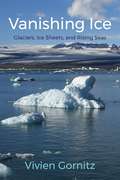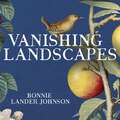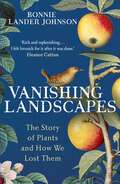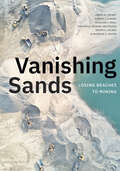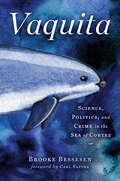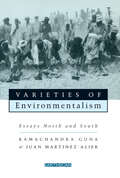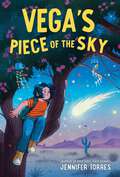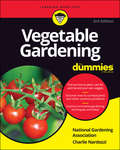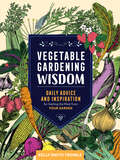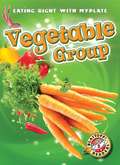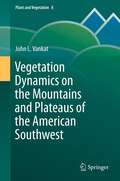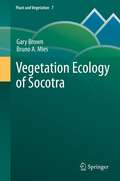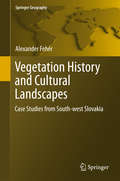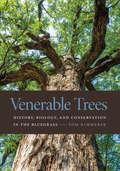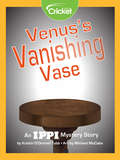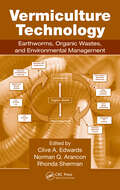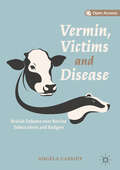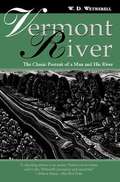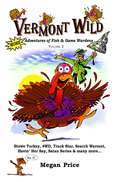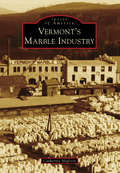- Table View
- List View
Vanishing Ice: Glaciers, Ice Sheets, and Rising Seas
by Vivien GornitzThe Arctic is thawing. In summer, cruise ships sail through the once ice-clogged Northwest Passage, lakes form on top of the Greenland Ice Sheet, and polar bears swim farther and farther in search of waning ice floes. At the opposite end of the world, floating Antarctic ice shelves are shrinking. Mountain glaciers are in retreat worldwide, unleashing flash floods and avalanches. We are on thin ice—and with melting permafrost’s potential to let loose still more greenhouse gases, these changes may be just the beginning.Vanishing Ice is a powerful depiction of the dramatic transformation of the cryosphere—the world of ice and snow—and its consequences for the human world. Delving into the major components of the cryosphere, including ice sheets, valley glaciers, permafrost, and floating ice, Vivien Gornitz gives an up-to-date explanation of key current trends in the decline of ice mass. Drawing on a long-term perspective gained by examining changes in the cryosphere and corresponding variations in sea level over millions of years, she demonstrates the link between thawing ice and sea-level rise to point to the social and economic challenges on the horizon. Gornitz highlights the widespread repercussions of ice loss, which will affect countless people far removed from frozen regions, to explain why the big meltdown matters to us all. Written for all readers and students interested in the science of our changing climate, Vanishing Ice is an accessible and lucid warning of the coming thaw.
Vanishing Landscapes: The Story of Plants and How We Lost Them
by Bonnie Lander Johnson'Rich and replenishing ... I felt lovesick for it after it was done'ELEANOR CATTON, Booker Prize-winning author'I really loved this book'JENN ASHWORTH'A brilliantly ambitious and authentic cultural history. A real treasure.'ROWAN WILLIAMS, former Archbishop of Canterbury__________In the past, we were deeply bound to all things green and growing. We once knew the landscape and the plants around us as well as we knew ourselves. But today our relationship with plants and nature has grown distant - we have lost a sense of plants as precious.Vanishing Landscapes tells the story of how plants disappeared from our daily lives one by one. First were apples, then household medicines like saffron, cloth dyes like woad, grapes for making wine, and then, eventually, the timber and reeds we used to build our houses and the wheat we grew for our bread. In their place came the first corporation, the first factory, the banking system, private property, global trade, and modern medicine.The history of these plants shows us how we became modern, but it also shows a path to recover some of what we have lost. In Vanishing Landscapes, Bonnie Lander Johnson goes in search of the old life and the people who are still connected to the land. She meets farmers in Ireland, wine makers in Yorkshire and cloth dyers in the Highlands. She cuts reeds in the watery Norfolk fens and camps overnight in a West Country orchard to gaze up at an unchanging sky.Vanishing Landscapes brings to life a world we never knew but still long for, and reminds us that it's not too late to find a way back.©2025 Bonnie Lander Johnson (P)2025 Hodder & Stoughton Limited
Vanishing Landscapes: The Story of Plants and How We Lost Them
by Bonnie Lander Johnson'Rich and replenishing ... I felt lovesick for it after it was done'ELEANOR CATTON, Booker Prize-winning author'I really loved this book'JENN ASHWORTH'A brilliantly ambitious and authentic cultural history. A real treasure.'ROWAN WILLIAMS, former Archbishop of Canterbury__________In the past, we were deeply bound to all things green and growing. We once knew the landscape and the plants around us as well as we knew ourselves. But today our relationship with plants and nature has grown distant - we have lost a sense of plants as precious.Vanishing Landscapes tells the story of how plants disappeared from our daily lives one by one. First were apples, then household medicines like saffron, cloth dyes like woad, grapes for making wine, and then, eventually, the timber and reeds we used to build our houses and the wheat we grew for our bread. In their place came the first corporation, the first factory, the banking system, private property, global trade, and modern medicine.The history of these plants shows us how we became modern, but it also shows a path to recover some of what we have lost. In Vanishing Landscapes, Bonnie Lander Johnson goes in search of the old life and the people who are still connected to the land. She meets farmers in Ireland, wine makers in Yorkshire and cloth dyers in the Highlands. She cuts reeds in the watery Norfolk fens and camps overnight in a West Country orchard to gaze up at an unchanging sky.Vanishing Landscapes brings to life a world we never knew but still long for, and reminds us that it's not too late to find a way back.
Vanishing Sands: Losing Beaches to Mining
by William J. Neal Orrin H. Pilkey Keith C. Pilkey Norma J. Longo Nelson G. Rangel-Buitrago Hannah L. HayesIn a time of accelerating sea level rise and increasingly intensifying storms, the world’s sandy beaches and dunes have never been more crucial to protecting coastal environments. Yet, in order to meet the demands of large-scale construction projects, sand mining is stripping beaches and dunes, destroying environments, and exploiting labor in the process. The authors of Vanishing Sands track the devastating impact of legal and illegal sand mining over the past twenty years, ranging from Africa, Asia, and the Caribbean to South America and the eastern United States. They show how sand mining has reached crisis levels: beach, dune, and river ecosystems are in danger of being lost forever, while organized crime groups use deadly force to protect their illegal mining operations. Calling for immediate and widespread resistance to sand mining, the authors demonstrate that its cessation is paramount for saving not only beaches, dunes, and associated environments but also lives and tourism economies everywhere.
Vapor Intrusion Simulations and Risk Assessments
by Qiang Chen Yijun YaoThis book introduces key concepts in modeling and risk assessments of vapor intrusion, a process by which the subsurface volatile contaminants migrate into the building of concern. Soil vapor intrusion is the major exposure pathway for building occupants to chemicals from the subsurface, and its risk assessments determine the criteria of volatile contaminants in soil/groundwater in brownfield redevelopment. The chapters feature the recent advances in vapor intrusion studies and practices, including analytical and numerical modeling of vapor intrusion, statistical findings of United States Environmental Protection Agency’s Vapor Intrusion Database and Petroleum Vapor Intrusion Databases, the challenges of preferential pathways, and the application of building pressure cycling methods, and field practices of vapor intrusion risk assessments at developed contaminated sites and in brownfield redevelopment. This volume also summarizes the advantages and limits of current applications in vapor intrusion risk assessment, laying the groundwork for future research of better understanding in risk characterization of soil vapor intrusion using models. Written by experts in this field, Vapor Intrusion Simulations and Risk Assessments will serve as an invaluable reference for researchers, regulators, and practitioners, who are interested in perceiving the basic knowledge and current advances in risk assessments of soil vapor intrusion.
Vapor: Poems
by Sara Eliza JohnsonSara Eliza Johnson’s much-anticipated second collectiontraces human emotion and experience across a Gothic landscape of glacial and cosmic scale. With a mind informed by physics, and a heart yearning for sky burial, Vapor’s epic vision swerves from the microscopic to telescopic, evoking an Anthropocene for a body and planet that are continually dying: “So alone / I open like a grave,” Johnson chronicles her love for “all this emptiness, this warp and transparence, the whorl of atoms I brush from your brow,” and considers how “each skull, / like a geode, holds a crystal colony inside.” Almost omnipresently, Vapor stitches stars to microbes, oceans to space, and love to pain, collapsing time and space to converge everything at once. Blood and honey, fire and shadow, even death and mercy are secondary to a profoundly constant flux. Facing sunlight, Johnson wonders what it would mean to “put my mouth to its / mouth, suck the fluid / from its throat, and give / it my breath, my skin, / which was once my / shadow,” while elsewhere the moon “is molten, an ancient red, and at its bottom is an exit wound that opens into another sea, immaculate and blue, that could move a dead planet to bloom.”In Vapor, Sara Eliza Johnson establishes herself as a profound translator of the physical world and the body that moves within it, delivering poems that show us how to die, and live.
Vaquita: Science, Politics, and Crime in the Sea of Cortez
by Brooke BessesenIn 2006, vaquita, a diminutive porpoise making its home in the Upper Gulf of California, inheritedthe dubious title of world's most endangered marine mammal.Nicknamed "panda of the sea” for their small size and beguiling facial markings, vaquitas have been in decline for decades, dying by the hundreds in gillnets intended for commercially valuable fish, as wellas for anendangered fish called totoaba. When international crime cartels discovered a lucrative trade in the swim bladders of totoaba, illegal gillnetting went rampant, and now the lives of the few remaining vaquitas hang in the balance.Author Brooke Bessesen takes us on a journey to Mexico's Upper Gulf region to uncover the story. She interviewed townspeople, fishermen, scientists, and activists, teasing apart a complex story filled with villains and heroes, a story whose outcome is unclear.When diplomatic and political efforts to save the little porpoise failed, Bessesen followed a team of veterinary experts in a binational effort to capture the last remaining vaquitas and breed them in captivity—the best hope for their survival. In this fast-paced, soul-searing tale, she learned that there are no easy answers when extinction is profitable.Whether the rescue attempt succeeds or fails, the world must ask itself hard questions. When vaquita and the totoaba are gone, the black market will turn to the next vulnerable species. What will we do then?
Varieties of Environmentalism: Essays North and South
by Ramachandra Guha Joan Martínez AlierUntil very recently, studies of the environmental movement have been heavily biased towards the North Atlantic worlds. There was a common assumption amongst historians and sociologists that concerns over such issues as conservation or biodiversity were the exclusive preserve of the affluent westerner: the ultimate luxury of the consumer society. Citizens of the world's poorest countries, ran the conventional wisdom, had nothing to gain from environmental concerns; they were 'too poor to be green', and were attending to the more urgent business of survival. Yet strong environmental movements have sprung up over recent decades in some of the poorest countries in Asia and Latin America, albeit with origins and forms of expression quite distinct from their western counterparts. In Varieties of Environmentalism, Guha and Matinez-Alier seek to articulate the values and orientation of the environmentalism of the poor, and to explore the conflicting priorities of South and North that were so dramatically highlighted at the Rio Earth Summit in 1992. Essays on the 'ecology of affluence' are also included, placing ion context such uniquely western phenomena as the 'cult of wilderness' and the environmental justice movement. Using a combination of archival and field data,. The book presents analyses of environmental conflicts and ideologies in four continents: North and South America, Asia and Europe. The authors present the nature and history of environmental movements in quite a new light, one which clarifies the issues and the processes behind them. They also provide reappraisals for three seminal figures, Gandhi, Georgescu-Roegen and Mumford, whose legacy may yet contribute to a greater cross-cultural understanding within the environmental movements.
Varmint Rifles and Cartridges: A Comprehensive Evaluation of Select Guns and Loads
by Charles T. RichardsA thorough guide, Varmint Rifles and Cartridges provides detailed information about getting started in varmint hunting, selecting the best rifles for the job, and choosing your cartridges and other components. The text is supplemented by more than one hundred detailed photographs that illustrate the various types of rifles and cartridges available for varmint hunters.Varmint Rifles and Cartridges presents information about the history of varmint hunting and how those original rifles differ from the most popular rifles and cartridges available for varmint hunters on the market today. Each chapter of the book is dedicated to a particular cartridge, including the: .204 Ruger .223 Remington .220 Swift .243 Winchester .257 RobertsAt the end of each chapter, author C. T. Richards demonstrates how each cartridge and rifle performs through the results of range tests and trajectory tests he conducted himself. A varmint hunter since the 1950s, Richards is more than qualified to grade these products and offer advice on varmint hunting in general.The content of Varmint Rifles and Cartridges will appeal to readers considering varmint hunting for the first time, as well those who have previously acquired some experience in using these tools.
Vega's Piece of the Sky
by Jennifer TorresA meteorite comes crashing down on the lives of three middle schoolers changing everything they know about family, friendships, and community in this charming and heartfelt novel with a light STEM touch. The space rock is just the latest thing to land, uninvited, in Vega Lucero&’s road-stop hometown. But when she discovers how much a chunk of the meteorite might be worth, she realizes it&’s exactly the treasure she&’s been hoping to find—and maybe a way to convince her mom not to sell the family store to big city developers to help pay for her grandpa Tata's medical expenses. Determined to find more pieces of the sky somewhere in the perilous desert wilderness, stubbornly independent Vega must set aside her distrust of outsiders to team up with Jasper, a would-be rival—and her own tagalong cousin Mila—on an overnight adventure to find more meteorites before the professional hunters who have descended on Date City do. But along the way, she realizes that she's not the only one with the weight of the world on her shoulders. Jasper and Mila have secrets and worries of their own that has brought them on this journey. Together, this ragtag group will battle against coyotes, a flood, and scorpions. But what they will ultimately discover is that no treasure is big enough to prevent unwelcome change. Only family and friends can help weather the unexpected that life brings.
Vegetable Gardening For Dummies (For Dummies Ser.)
by Charlie Nardozzi National Gardening AssociationVegetables from your own farm to your own table We all love good food, and the fresher it is, the better! And what could be fresher than farm-to-table terms than vegetables you've grown at home? The new edition of Vegetable Gardening For Dummies puts you in touch with your roots in a thousands of years old farming tradition by demonstrating how easy it is to grow your own. And there's no need to buy a farm: all you need to become a successful cultivator of the land is this book and a small plot of soil in the yard, or a container set aside for some tasty natural edibles. Add water and some care, love, and attention—et voila! In a friendly, come-relax-in-my-garden style Charlie Nardozzi—leading horticultural writer and guest expert on shows such as Martha Stewart Living Radio—shares the nutritious results of a lifetime of vegetable-growing experience to delve into the nitty-gritty of micro-farming. It's not rocket science—quite the opposite—but you do need a bit of patience before you can reap your first glorious harvest. This book shows you how to master that, as you get down and dirty with the enjoyable work of building soil, starting seeds, controlling pests, and maintaining your garden. And as your early efforts turn to green shoots, you can dig deeper into information on special tips and tricks, as well as hundreds of vegetable varieties—many of which are beautiful to behold as well as tasty to eat! Plan out your garden Know your veggies, from tomatoes to chard Keep your plants happy and healthy Harvest, store, and preserve your crops Whether your thumb is a fertile green or you've never put plant-to-pot before, this book will bring out your inner farmer: you'll find everything required to transform your garden into a self-renewing larder—and complement every meal with a crisp, healthy, home-grown treat.
Vegetable Gardening Wisdom: Daily Advice and Inspiration for Getting the Most from Your Garden
by Kelly Smith TrimbleSometimes the best gardening advice comes in tidbits shared over the fence by a sage neighbor. In Vegetable Gardening Wisdom, master gardener Kelly Smith Trimble shares her tried-and-true ideas and guidance for succeeding at and enjoying every aspect of herb and vegetable gardening. This lively, beautifully designed package makes a perfect gift and a source of daily inspiration, as Trimble invites readers to dip in regularly for bite-sized pieces of information on everything from gardening itself to cooking and preserving, creative ways to use the harvest, and ideas for reducing garden and kitchen waste. Discover the best herbs to grow indoors, the best way to start peas, how to use lettuce as a living mulch in the garden, how to make compost tea, how to identify beneficial bugs, how to blanch cauliflower, and much more. Woven in among Trimble's tips are helpful and inspiring quotes from other plant-loving folks, including novelist Jamaica Kincaid, vegetable gardening guru Ed Smith, and renowned chef Sean Brock. This publication conforms to the EPUB Accessibility specification at WCAG 2.0 Level AA.
Vegetable Group
by Megan Borgert-SpaniolRelevant images match informative text in this introduction to the vegetable group. Intended for students in kindergarten through third grade,
Vegetation Dynamics on the Mountains and Plateaus of the American Southwest
by John VankatThe book provides information essential for anyone interested in the ecology of the American Southwest, including land managers, environmental planners, conservationists, ecologists and students. It is unique in its coverage of the hows and whys of dynamics (changes) in the major types of vegetation occurring on southwestern mountains and plateaus. It explains the drivers and processes of change, describes historical changes and provides conceptual models that diagrammatically illustrate past, present, and potential future changes. All major types of vegetation are covered: spruce-fir, mixed conifer, and ponderosa pine forests, pinyon-juniper vegetation, subalpine-montane grassland, and Gambel oak and interior chaparral shrublands. The focus is on vegetation that is relatively undisturbed, i.e., in natural and near-natural condition, and how it responds to natural disturbances such as fire and drought, as well as to anthropogenic disturbances such as fire exclusion and invasive species
Vegetation Ecology of Socotra
by Bruno Mies Gary BrownAlthough the unique flora of the Socotra Archipelago with its high degree of endemism has received much attention recently, little information is available on the vegetation and related ecological aspects. Based on their extensive field experience of the region, the authors have assimilated a vast amount of knowledge to produce this book, which gives a detailed insight into the plant ecology of Socotra, designated as a World Heritage Site by UNESCO in 2008. The book is divided into seven chapters. After a brief introduction and overviews of important abiotic features, various aspects of the vascular flora are presented in Chapter 4, together with accounts of the bryophyte and lichen flora. Ecology and adaptive strategies of the plants are dealt with in Chapter 5, and Chapter 6 gives a concise description of the main vegetation units. Finally, important management issues of the vegetation are discussed, an essential topic to ensure preservation of the natural heritage of the archipelago.
Vegetation History and Cultural Landscapes: Case Studies from South-west Slovakia (Springer Geography)
by Alexander FehérThis book focuses on the vegetation history of the cultural landscape in southwestern Slovakia, which was established and adopted by mankind and has since constantly evolved in response to ongoing changes (in environmental conditions, biodiversity, land use, etc.). The book analyses four dominant ecosystems typical for the cultural landscape and affected by humans: woodlands, wetlands, grasslands and agricultural land. Each ecosystem is discussed in separate chapters. The chapters include (a) basic information, general aspects, development processes, trends and interpretations, (b) a published or non-published case study based on the author’s own research, and (c) an extensive bibliography. A set of maps on the vegetation history and indices of geographical names and plants names serve to round out the coverage. The work provides an essential point of departure for describing the typical regional characteristics of the cultural landscape, with an eye to its future preservation.
Venerable Trees: History, Biology, and Conservation in the Bluegrass
by Tom Kimmerer“Will likely become a classic among books about Kentucky’s natural history and environment, because it covers so much new information.” —Lexington Herald-LeaderWhen the first settlers arrived in the Bluegrass region of Kentucky, they found an astonishing landscape of open woodland grazed by vast herds of bison. Farmers quickly replaced the bison with cattle, sheep, and horses, but left many of the trees to shade their pastures. Today, central Kentucky and central Tennessee still boast one of the largest populations of presettlement trees in the nation, found in both rural and urban areas.In Venerable Trees: History, Biology, and Conservation in the Bluegrass, Tom Kimmerer showcases the beauty, age, size, and splendor of these ancient trees and the remaining woodland pastures. Documenting the distinctive settlement history that allowed for their preservation, Kimmerer explains the biology of Bluegrass trees and explores the reasons why they are now in danger. He also reveals the dedication and creativity of those fighting to conserve these remarkable three-hundred- to five-hundred-year-old plants—from innovative, conscientious developers who build around them rather than clearing the land to farmers who use lightning rods to protect them from natural disasters.Featuring more than one hundred color photographs, this beautifully illustrated book offers guidelines for conserving ancient trees worldwide while educating readers about their life cycle. Venerable Trees is an informative call to understand the challenges faced by the companions so deeply rooted in the region’s heritage and a passionate plea for their preservation.“A fascinating book about a unique landscape in the Bluegrass Region of Kentucky.” —Frans Vera, author of Grazing Ecology and Forest History
Venus's Vanishing Vase: An I.P.P.I. Mystery Story
by Kristin O'Donnell TubbIn this story, four friends who are members of the InterPlanetary Private Investigators solve a mystery that takes place on the planet Venus.
Veranda Elements of Beauty: The Art of Decorating
by Veranda Kathryn O'Shea-Evans"This new book by Veranda is a must for anyone's library who is passionate about design." --Bunny Williams, Interior Designer Explore this magnificent global collection of beautiful homes from VERANDA and become inspired by the talented designers and architects who created them.Our innate desire for beauty is every bit as powerful as our yearning for love and happiness. The editors of Veranda spoke with dozens of interior designers, architects and landscape designers--including Ellie Cullman, Celerie Kemble, Thomas A. Kligerman, Brooke and Steve Gianetti, Katie Ridder, Keith Robinson, Stephanie Sabbe, Mark D. Sikes, Ruthi Sommers, Colette van den Thillart, and Bunny Williams--about how they introduce beauty into the spaces they design so lovingly. Organized by room, each chapter displays both the grandeur of interiors and those special details that make a room arresting, reminding readers that some of the most beauteous thrills can happen in any corner of the home. From kitchens and bathrooms to bedrooms and gardens, these are the glorious spaces that feel as good as they look and invite us in with their enthralling combination of color, pattern, and texture, along with stunning architectural features like beamed ceilings, Venetian plaster walls, and an arbor fireplace. Step inside spectacular homes in exclusive locations like Palm Beach, New Orleans, Provence and Mustique to find: • Stunning color photographs that illuminate the designers' process, room by room • Personal advice on creating delightful living environments • How balance and scale are achieved in every space, from grand architectural elements to small details • An intimate view of light-flooded sunrooms, jewel-colored high-gloss walls, bronze window casings, antique doors, displays of Japanese textiles, and superbly dressed beds • Inspiration to live beautifully and gracefully and to establish your own personal style
Veranda Escapes: Alluring Outdoor Style
by Clinton Smith VerandaThis lavish book from Veranda—the magazine that knows the art of luxurious living—offers a wealth of ideas for creating exceptional outdoor rooms and spaces. You&’re invited to enjoy abundant gardens, elegant porches, stunning courtyards, and magnificent pools—all of which grace homes designed by the world&’s best, most influential designers. Covering elements of outdoor style like lush landscapes, verdant escapes, and evocative views, Veranda Escapes: Alluring Outdoor Style provides insider access to dozens of breathtaking designs from around the world and in many different styles. They include a resplendent Connecticut &“garden of Eden,&” artfully framed by clipped hedges and swathes of green; a sensual, spiritual, and rose-filled coastal enclave in Montecito; a Moroccan-inspired dream house in Dallas; and a glamorous oceanfront estate in Palm Beach with a courtyard and a set of loggias. They will inspire you to create your own gracious, exquisite outdoor spaces.
Vermiculture Technology: Earthworms, Organic Wastes, and Environmental Management
by Rhonda Sherman Clive A. Edwards Norman Q. AranconCo-edited by international earthworm expert Clive A. Edwards, Vermiculture Technology: Earthworms, Organic Wastes, and Environmental Management is the first international, comprehensive, and definitive work on how earthworms and microorganisms interact to break down organic wastes on a commercial basis. Many books cover the importance of composting
Vermin, Victims and Disease: British Debates over Bovine Tuberculosis and Badgers
by Angela CassidyThis open access book provides the first critical history of the controversy over whether to cull wild badgers to control the spread of bovine tuberculosis (bTB) in British cattle. This question has plagued several professional generations of politicians, policymakers, experts and campaigners since the early 1970s. Questions of what is known, who knows, who cares, who to trust and what to do about this complex problem have been the source of scientific, policy, and increasingly vociferous public debate ever since. This book integrates contemporary history, science and technology studies, human-animal relations, and policy research to conduct a cross-cutting analysis. It explores the worldviews of those involved with animal health, disease ecology and badger protection between the 1970s and 1990s, before reintegrating them to investigate the recent public polarisation of the controversy. Finally it asks how we might move beyond the current impasse.
Vermont River
by W. D. WetherellSelected by Trout magazine as one of the thirty finest fly-fishing books, "Vermont River" is the brilliant chronicle of a writer and fisherman. It is a book of rare and genuine beauty, a celebration of fly fishing, the natural world, and a river valley and the life in it. The first of Wetherell's trilogy lauding his love of a sport and a region, "Vermont River" is a must for anyone who loves good literature.
Vermont Wild: More Adventures of Fish and Game Wardens (Volume #2)
by Megan PriceMore hilarious, true game warden adventures. Laugh along as the officers set up a sting, confront cunning poachers, try to train a wily deputy dog, conduct searches and wrestle uncooperative critters. Loved by all ages.
Vermont's Marble Industry
by Catherine MiglorieThe marble deposits in Vermont are some of the richest in the world. Vermont's Marble Industry takes readers deep inside the quarries of the Green Mountain State to show how stone was sawed and raised from the earth to be cut, polished, and carved into monuments and structures that today are spread across the country. During the late 1800s, the marble industry flourished and the mighty Vermont Marble Company was started by a local family. The patriarch of the Proctor family built the Vermont Marble Company into the largest stone company in the world. They hired immigrant workers to fuel the company, and the region became a melting pot of nationalities. After World War II, demand for blocks of heavy dimension stone diminished and the slow demise of the Vermont Marble Company began. Vermont's Marble Industry proudly tells the history of the marble workers, their skilled craftsmanship, and the communities that relied on this industry.
